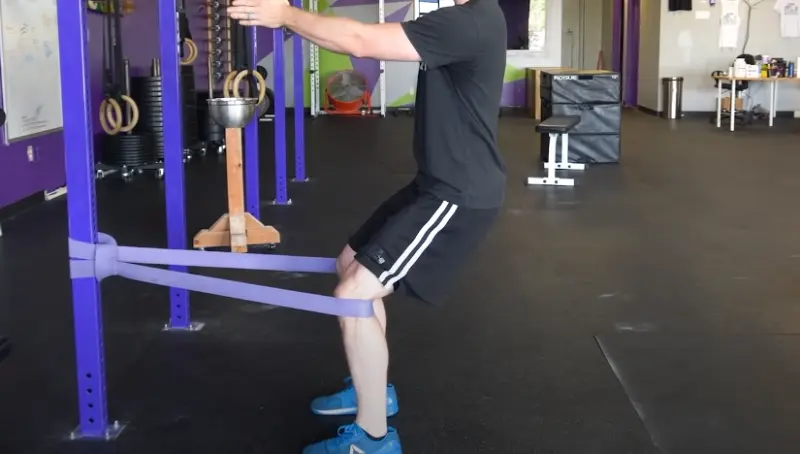Repeated activities like jumping and pedaling can increase the risk of patellar tendonitis, causing pain between the kneecap and shinbone. Improper cycle seat positioning can strain the tendon, increasing knee pressure during physical activity or intense workouts.
It is advised to reduce activities that aggravate Patellar Tendinopathy when it is reactive. This includes minimizing cycling, especially in more intricate gears, on uphill inclines, or when exerting higher intensity.
In this blog post, we’ll explore the effects of Cycle With Knee Tendonitis, the benefits of cycling for knee tendonitis management, and tips for safe cycling with a knee injury.
Can I Cycle With Knee Tendonitis: 8 Expert Steps

While cycling can provide a low-affected means of fortifying your lower body and enhancing cardiovascular health, it’s essential to consider both the potential advantages and disadvantages.
The Benefits of Cycling on Knee Tendonitis
Knee tendonitis involves the inflammation or irritation of the tendons attached to the knee joint. Often caused by overuse or repetitive strain, knee tendonitis can make engaging in physical activities such as cycling challenging. If managed correctly, cycling can help alleviate the symptoms of knee tendonitis.
Reduce Knee Stress With Low-Impact Exercises
Cycling is a low-affected exercise beneficial for individuals with knee tendonitis. Cycling puts less strain on the knees than other activities, such as running or jumping. Individuals with knee tendonitis can engage in physical activity by cycling without worsening their condition. Low-affected exercise has several benefits for knee tendonitis:
- Knees are relieved of pressure and impact.
- Maintaining joint mobility is made easier with it.
- Tendon inflammation is treated with it.
Boosts Circulation and Promotes Healing
Circulation in the body is improved by cycling. Blood circulates throughout the body through blood vessels. Inflammation and healing depend on proper circulation. Cycling increases blood flow to the affected area, reducing inflammation and speeding recovery. Here are a few circulation benefits of cycling:
- Muscles and tendons can heal faster because they are provided with oxygen and nutrients.
- Pain and stiffness are reduced as metabolic waste is removed from the tissues.
- Infection risks are reduced because it enhances the immune system.
Strengthens Muscles That Support the Knees
Cycling has many benefits for individuals with knee tendonitis, as it strengthens the key muscles supporting the knee joint – quads, glutes, and hamstrings. Regular cycling enhances muscle strength and endurance, relieving pressure on the knee joint. Let’s explore the remarkable benefits of cycling for muscle strengthening.
- Knee pain can be reduced by reducing muscle imbalances.
- Injuries can be prevented by improving overall fitness.
- The exercise enhances joint stability and prevents further damage to the knee joint.
The Adverse Impact of Cycling on Knee Tendonitis

Cycling can help and harm a knee injury if you can’t treat it carefully. Individuals will experience different effects. Here are some ways cycling can affect knee tendonitis:
- Reduced Impact: Cycling does not put as much strain on the joints as running or jumping. The risk of further injury can be reduced by cycling if you have knee tendonitis.
- Inflammation: Cycling is a repetitive exercise, and the constant bending and extending of the knee joint can irritate.
- Duration and Intensity: Your cycling routine may positively or negatively affect your symptoms. Start with short, moderate rides and accumulate time and power to avoid additional knee damage.
Potential Worsening of Symptoms
You should remember that cycling can cause your symptoms to persist or worsen if you continue to exercise. You may overdo it if you exhibit the following signs:
- Pain during and after sharp or lingering exercise.
- Exercise-induced swelling or stiffness that disappears after a few hours.
- Knee pain or difficulty bending or straightening.
- Discomfort affects the way you move or walk.
You should consult your doctor if you experience these symptoms while cycling.
Risk of Further Injury
Any sport or exercise after an injury carries some risk of further damage. There is no exception to cycling. Among the additional risks are:
- Falling off your bike after losing your balance.
- Tendons and muscles of the knee are overworked.
- Increasing inflammation and aggravating the damage.
Long-Term Effects of Cycling with Knee Tendonitis
While cycling can benefit those with knee tendonitis, there may be better long-term options. Knee pain can eventually progress to osteoarthritis, characterized by cartilage loss and joint damage. Because of repetitive motions, long-term cycling can exacerbate this condition.
Cycle with Knee Tendonitis: 3 Precautions
Cycling with knee tendonitis requires caution and proper precautions. Here, it explores essential measures to consider when cycling under this condition. By following these guidelines, you can continue to benefit from cycling without worsening your symptoms.
Exercise without Overexertion
Overexertion can worsen knee Tendonitis symptoms, so avoiding it is crucial. To prevent overexertion, follow these guidelines:
- If you experience severe pain or swelling, avoid cycling for extended periods or at high intensity.
- After cycling, stretch to promote recovery by warming up adequately.
- Taking regular breaks and listening to your body is essential.
Gradual Increase in Intensity
For individuals with knee tendonitis, it is crucial to increase cycling intensity gradually. Rushing into intense workouts can worsen the injury and exacerbate the pain.
- Accumulate length by starting with shorter rides.
- Give your knee time to adapt by accumulating your cycling intensity over several weeks.
- Allow your body to recover between rides by taking rest days.
Avoid Hills and Rough Terrain
When cycling with knee tendonitis, avoiding hills and rough terrain is best. Knee pain and discomfort can be exacerbated on these types of terrain. Consider these alternatives:
- When cycling, stay on flat surfaces and avoid steep inclines.
- Instead of bumpy surfaces, choose smooth roads or bike trails.
- Alternatives to outdoor cycling include stationary bikes indoors.
Stretching Techniques for Healthy Knee Tendons
Maintaining healthy knee tendons is crucial for overall joint health and mobility. Here are some essential knee stretches that can help keep your knees flexible and reduce the risk of pain and injury:
- Knee Straighteners: This beginner-friendly stretch targets both the knees and hips. As you straighten your knee, you’ll loosen up the surrounding muscles.
- Straight Leg Raises: Similar to knee straighteners, this exercise extends the knee and stretches the tendons and muscles on the backside of your knee joint.
- Lying Hamstring Stretch: The hamstring muscle crosses the back of the knee. To relieve tightness in this area, try the lying hamstring stretch.
- Standing Quad Stretch: This stretch focuses on the muscles and tendons in the front of your knee joint. You’ll feel the stretch in your quads (front of your thigh).
- Calf Stretch: The calf muscles are attached to the back of your knee. If your calf is tight, it can pull on the knee joint and cause discomfort. A calf stretch can help ease this.
- Seated Hamstring Stretch: Especially beneficial for runners, this stretch targets the hamstrings, relieving pressure on the knee. Tight hamstrings can contribute to knee issues and leg soreness.
Major Tendons In the Knee
Let’s delve into the major tendons in your knee. These structures play a crucial role in maintaining knee stability and facilitating movement. Here are the key tendons:
Patellar Tendon
- The patellar tendon connects the kneecap (patella) to the shinbone (tibia).
- It plays a crucial role in knee extension, allowing you to straighten your leg.
- When you contract your quadriceps muscle, the patellar tendon facilitates leg extension.
- This tendon is part of the extensor mechanism of the knee.
Quadriceps Tendon
- The quadriceps tendon connects the quadriceps muscle (located on the front of your thigh) to the kneecap (patella).
- It provides stability and power during knee extension.
- The quadriceps tendon is essential for activities like walking, running, and jumping.
Hamstring Tendons
- The hamstring tendons are a group of tendons at the back of your knee.
- They connect the hamstring muscles (located on the back of your thigh) to the bones of the lower leg (tibia and fibula).
- These tendons play a role in knee flexion (bending) and stability.
Causes of Knee Tendonitis
Knee tendonitis, also known as patellar tendinitis or jumper’s knee, happens when the tendon connecting your kneecap to your shinbone becomes inflamed or irritated. Let’s explore the causes and risk factors:
Overuse and Repetitive Stress
Patellar tendinitis is a common overuse injury caused by repeated stress on the patellar tendon. Activities such as running, jumping, and squatting can put extra strain on the tendon. Tiny tears develop in the tendon because of this repetitive stress, leading to inflammation and weakening of the tendon.
Physical Activity
Running and jumping are most commonly associated with patellar tendinitis. Sudden increases in the intensity or frequency of these activities can add stress to the tendon. Even changing your running shoes can affect the tendon.
Tight Leg Muscles
Tight thigh muscles (quadriceps) and hamstrings (which run up the back of your thighs) can increase strain on the patellar tendon. Maintaining flexibility in these muscles is essential to prevent excessive tension on the tendon.
How to Cycle with Knee Tendonitis: 4 Tips
Cycling with knee tendonitis can be challenging, but managing and easing pain with the right tips is possible. Ice therapy effectively reduces inflammation, while stretching exercises can improve flexibility and loosen tight muscles. Following these recommendations, you can continue cycling while caring for your knee health.
Stretching Exercises

Stretching exercises can also relieve tightness in the muscles, which can be helpful for people with knee tendonitis. You can stretch by doing the following activities:
- Calf stretch: Face a wall with your hands against it. Step back with your foot farthest from the fence and press your heel to the ground. After 10-20 seconds of holding, switch sides.
- Hamstring Stretch: Lie on the ground with your legs straight out before you. Hold your toes for 10-20 seconds.
- Quadriceps Stretch: Stand shoulder width apart, grabbing your ankle with one hand. Switch sides after holding for 10-20 seconds.
- Hip flexor Stretch: Lean forward on one knee until you feel the stretch in your hip. Switch sides after 10-20 seconds.
Simple exercises can ease tight muscles and joints and reduce knee tendon strain. Warm up before cycling for 10-15 minutes.
Ice Therapy to Relieve Pain and Inflammation
- Knee tendonitis can be effectively treated with ice therapy by reducing pain, swelling, and inflammation.
- Add ice to the affected knee for up to 20 minutes a day.
- Avoid direct contact with the skin using cold compresses, ice packs, or bags of frozen peas wrapped in a towel.
- Heat therapy can worsen inflammation, so avoid it.
Proper Posture and Technique
Correct posture and technique are also critical when cycling with knee tendonitis. Pain and discomfort can be minimized by doing this. Here are some methods to remember:
- Relax your shoulders and keep your back straight.
- Your knee tendons will be less stressed when your knees are aligned with your feet.
- Engaging your lower leg muscles by pushing with the ball of your foot.
- To minimize knee strain, keep your cadence high.
- Keep a smooth pedal stroke and avoid sudden or jerky movements.
Wearing Knee Supports
Cycling with knee supports can help manage knee tendonitis. You can choose from the following knee supports:
- Compression Sleeves: They reduce swelling and inflammation by compressing and supporting the knees.
- Braces: Braces reduce the chance of medial and lateral knee movement by providing additional support.
- Straps: Straps reduce pain and stress on the patellar tendon through additional support.
Conclusion
Knee tendonitis can negatively affect a cyclist’s passion for cycling. Cycling can be enjoyed without worsening cyclist conditions when precautions are taken. Cycling safely, including proper stretching, posture, and intensity, prevents knee tendonitis among cyclists.
It is important to remember that cycling is a low-impact activity that can help promote healing and strengthen the muscles supporting the knee. Taking precautions and enjoying this fantastic exercise can assist if you are a cyclist suffering from knee tendonitis.
FAQs
Is It Possible To Run With Knee Tendonitis?
While it may be feasible to continue running despite having patellar tendonitis, certain adjustments are likely necessary. It is crucial to remember that engaging in activities that induce pain does not contribute to the healing process of the tendon.
Is Cycling Good For Knee Tendonitis?
The early stages of rehab may also benefit from cycling if you are without pain, but it is far from ideal. Force and time under tension are more challenging to track than in conventional tendon exercises.
How Long Does Tendonitis Last In The Knee?
Patellar tendonitis often clears in six weeks if treated properly and rested enough. Physical therapy and other serious cases may take months to fully recover, though relief is often felt after a few weeks sometimes.
Can Peroneal Tendonitis Cause Knee Pain?
Peroneal tendons run from the upper leg to the knee, ankle, and foot. You can feel pain in your leg, knee, ankle, and foot when these tendons get inflamed. Joint damage can cause ankle and knee pain at the same time.


